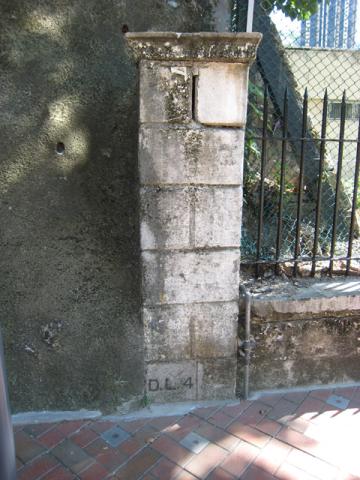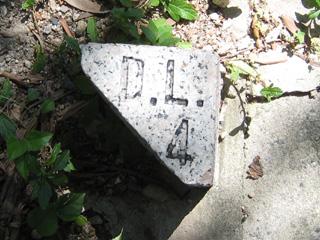You've likely seen at least one of these around Hong Kong:
These old stones marked the boundary of a piece of land used by the British Armed forces. Here are the stones we know of (click an entry in the list, or a marker on the map, for more details about that stone):
The map below is 'live': you can drag it around with your mouse, click the +/- buttons to zoom in and out, and click the Map/ Satellite/ Hybrid buttons to change the appearance of the map.
Air, Land, and Sea
The stone shown above is an example of a War Department Boundary Stone, used to mark out the army's land. You'll see 'W D' engraved on the stone, together with an upward-pointing arrow.
There are also several Naval Boundary Stones still around. You'll recognise them by the anchor engraved on them. They marked land belonging the Royal Navy. At the time these stones were used, the authority in command of the Navy was called the Admiralty, so you'll also see these stones called Admiralty Boundary Stones. Here's one on the lawn in front of Flagstaff House:
Next the Air Ministry Boundary Stone. You can see the 'A M' initials on this example from the UK, but I don't know if there were / are any here in Hong Kong. Has anyone seen one? Perhaps around the RAF buildings in Kwun Tong?
A stone's features
Regardless of the type of stone, the typical design is a granite block, around one foot square, with the design engraved on one side. Some were flat on top, some rise to a point. I'm not sure if the flat / point difference tells us anything useful (eg the year the stone was erected?), or if they just varied by chance.
Each stone has a number. A map of the 'Cantonment of Victoria' [1] shows us that the stones were numbered in sequence along each boundary. eg WD stone #37 is still at, or very near to its original location, and was part of the boundary around the barracks area where Hong Kong Park and Pacific Place are today.
The lowest numbered stone along this boundary was #17, at the bottom of Monmouth Path in Wanchai. From there they were numbered in an anti-clockwise direction along Queen's Road (today's Queensway), around the old parade ground, up Garden Road and Boundary Path to Kennedy Road, past #37, then along Kennedy Road until it reached the hillside above Monmouth Path. The last section of the boundary ran downhill again til it reached #43, and back to the starting stone, #17.
The Naval stone shown above also has a date, 1910. Moddsey explains:
The Stone represented the boundary of the enlarged Royal Naval Dockyard in 1910. In line with the expansion of the China Station, the Royal Navy had also acquired North and Wellington Barracks (north of Queensway) from the Army.
See them while you can
Although stones #1..16 don't appear on the map above, it's clear that there were a large number of stones. In total I counted 118 stones marked on the map! Originally I thought I knew of four remaining. When I looked, one of those has already disappeared, leaving just three still standing. So, see them while you still can.
Defence Lot Boundary Stones
The modern equivalent of the old boundary stones described above is the Defence Lot Boundary Stone. I'm not sure exactly when the change happened, but it was likely during or after 1964, the year that the Admiralty, War Office and Air Ministry merged to become the Ministry of Defence [2].
The new stones use a different numbering system. Each stone shows the number of the Lot whose boundary they mark, so all stones around one Lot show the same number. Here's a couple of the stones around Defence Lot #4, the area that used to be known as ‘Queen’s Lines’, and is now called ‘Ching Yi To Barracks’. This one is at the base of a pillar where Queens Rd East turns into Queensway:
And this is on the corner of the junction where the road to the barracks turns off from Justice Drive.
Are there more?
If you know of any others, please can you let us know?
The quickest way is to leave a comment, but the best way is to create a new place and give it one of these tags:
- war department boundary stone
- naval boundary stone
- air ministry boundary stone
Then it will automatically be added to the map and list above. Let us know if you need any help creating the place.
If you know any other stories or information, (or you can spot any mistakes I've made!), it will be great to hear from you. Please leave a comment below.
Regards, David
References:
[1] 'Hong Kong, Cantonment of Victoria, c.1924', ref:HG7, Survey & Mapping Office
[2] 'Ministry of Defence' entry on Wikipedia
[3] The 'War Department Boundary Stones' photo pool on Flickr. Over 200 of them!




Comments
Another format for the stones
Moddsey has spotted this one at Signal Hill:
It has the initials 'W.D.L.", which I guess were for 'War Department Lot'. Maybe this was an intermediate format between the older 'W.D.' stones, and the newer 'D.L. stones?
Stones around the Robert & Montgomery Blocks
Today I took a walk around the land where these two blocks stand. Although most of the military land was north of Kennedy Road, there was also a strip of land to the south. First was the lot between Kennedy Road and Bowen Road, where the Robert & Montgomery Blocks stand today. Then south again there was the lot for the Military Hospital.
I started on Bowen Road, looking for the stone #7 from the hospital lot which Moddsey had found. He's got good eyesight! I'd missed it on my first visit, but don't feel so bad about it now. See if you can spot it:
Here's a closer view that should make it clear:
The old map of the area showed that stone #3 of the Robert/Montgomery lot should be directly opposite this stone#7, on the other side of Bowen Road. I wasn't very confident about finding it though, as the Borrett Road bridge and embankment had been built since the map was drawn.
But, here's the view looking over from stone #7, and there's the likely-looking square stone on the embankment:
A closer look didn't show much at first:
But it turned out it was just covered with mud. A quick scrape with a stick showed the WD initials:
I walked along Kennedy Road, and was pleasantly surprised to find stones #5 and #6 still visible, so three out of seven for this lot are still around.
Here is #5, mostly buried but with the top still peeking out:
And here is #6, doing it's best to stay visible, despite a coat or two of the spray-on concrete:
Rob Weir has also written in to say there are a few along the road up to the Mount Davis Battery. Any others we are missing?
Regards, David
Stones along Mount Davis Path
I took a walk today, to look for the stones that Rob mentioned. They're approximately a third a way along the road, if you're walking up from the bottom. They are near to a small concrete building - not sure what it was, but it didn't look sturdy enough to have been a military building.
Here's the first stone, with yet another layout: arrow on top line, 'WD' on middle, and number on the bottom. It's hard to make out the number, but it looks as though it may have been '11'.
A short distance ahead is the second stone:
It looks as though the number was originally '19', but was then changed to '11'. Why was the number changed? Maybe the stone was relocated? Or the wrong number was carved initially? Or perhaps 19 was the old style when each stone had it's own number, then later they changed to have all stones showing the lot number? Or ... ?
I walked up to the top of the hill, but didn't see any other boundary stones. If there are more, we'll need to see a map of the original lot boundary to find them.
W D with arrow sign in between
The arrow sign between W and D = Water works Department. Arrow sign is the sign of Government property
re: W D with arrow sign in between
For all the boundary stones we've seen so far, they have been at the edge of land that was used by the army. I believe the 'W D' on those stones represents 'War Department'.
It's also a good chance to mention another comment, where the writer suggests that the 'W D' represents 'Works Department'. If you see something related to that department from the early 20th Century, I think the initials used were 'PWD', for Public Works Department. I'm not sure if water works would also come under this group?
I don't think it's likely they'd have had one type of stone with two or different meanings, but I'm happy to be proved wrong. Have you seen any stones marked 'W D' that you are sure belonged to the water department?
Regards, David
War Department Boundary Stones - Signal Hill
Made another tour of Signal Hill. Here is the orignial WDBS located on Minden Row, near the garbage collection depot and path leading up to Signal or Blackhead's Hill
Perhaps the re-adjustment of the WDBS in later years to the W.D.L types seen below was brought about by the requisitioning of military land by the Government for the installation of the Observatory's Time Ball Tower.
w d stones
these stone are in a few location in the town i live in ballinrobe mayo ireland
i was told wd = war department. the stone also has the upturned arrow,i was also told that the stones were used by the army for height above sea level,there was a barracks in the town,but one of the wd stone is on the steps of the convent which is the highest level above sea level in the town.were the stones used for map and measurments for constrution.
thanks james
Possible Military boundary stone
Hi,
Near Clearwater bay school in Clearwater bay road, there is a stone on the pavement with a figure 8 on it. Is this a military bounday stone?
Military Stones and Markings
Nice views of types of military boundary stones from the U.K. here from B.O. to W.D.